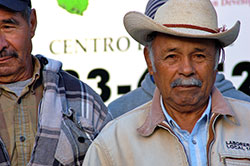For Immediate Release
Department of Health Services Releases Results of Local Farmworkers Health Survey
FOR IMMEDIATE RELEASE
Santa Rosa,CA | October 19, 2015
 Today, the Sonoma County Department of Health Services (DHS) released the first- ever study of local farmworkers' health and well-being (PDF: 2.5 Mb). The main finding from the study found that the vast majority of farmworkers permanently reside in Sonoma County with their families.
Today, the Sonoma County Department of Health Services (DHS) released the first- ever study of local farmworkers' health and well-being (PDF: 2.5 Mb). The main finding from the study found that the vast majority of farmworkers permanently reside in Sonoma County with their families.
“The farmworker health survey provides essential information about the wellbeing of our farmworkers and their families, addressing key issues such as housing and healthcare. This report will be essential in highlighting areas of opportunity to improve the health of a population key to our community’s economy and vitality,” stated Sonoma County Supervisor Efren Carrillo, liaison to the Department of Health Services.
This data describes the health status of these farmworkers and discusses the health inequities among members of our community, whom results show permanently reside here in the County year-round.
The key findings from the farmworker health survey included: the majority of farmworkers are permanent residents of Sonoma County and live with their families; farmworker families live in unaffordable and overcrowded housing conditions in Sonoma County; nearly all local farmworker families earn insufficient incomes to meet their family’s basic needs; due to limited health insurance coverage, farmworkers have restricted access to preventative and medical care; and farmworkers experience significant health disparities here in the County.
“These farmworkers are long-standing members of our community. Their families live here and their children are students in our local schools and represent our future workforce. In order to ensure the County’s continued success, we must ensure their success moving forward. This survey underscores where the needs are for this community and presents opportunities where we can act moving forward,” said Brian Vaughn, Director of Health Policy, Planning and Evaluation Division, DHS.
The Sonoma County Farmworker Health Survey was a survey of 293 farmworkers in Sonoma County between September 2013 and January 2014, which aimed to describe the health and well-being of farmworkers in Sonoma County. The survey can be accessed online at the DHS website and on the LiveStories platform. DHS partnered with the Public Health Institute, California Healthcare Foundation and LiveStories to create this story using the LiveStories platform. To learn more about how farmworkers in the County experience challenges regarding their health and to hear about their stories please visit LiveStories.
DHS’ main partner in this survey was California Human Development. DHS also reached out to the agricultural community for input and feedback during the data collection phase and the dissemination of the survey results.
“Significantly many of the farmworkers we interviewed indicated that Sonoma County was their permanent home and that their intention was to remain in Sonoma County and raise their families here. The report highlights the significant health disparities experienced by farmworkers. The recommendations will provide a framework for our efforts going forward to reduce these disparities and ensure that farmworkers are truly part of our community,” said Chris Paige, Chief Executive Officer, California Human Development.
DHS appreciates the farmworkers that participated in this survey for sharing their experiences and stories. The survey was supported by the Cooperative Agreement 1H75DP004611-01 from the Centers for Disease Control and Prevention. Its contents are solely the responsibility of the authors and do not necessarily represent the official views of the Centers for Disease Control and Prevention.
![]() Full report (PDF: 2.5 Mb)
Full report (PDF: 2.5 Mb)
Executive summary (PDF: 486 Kb)
###
 Translate
Translate